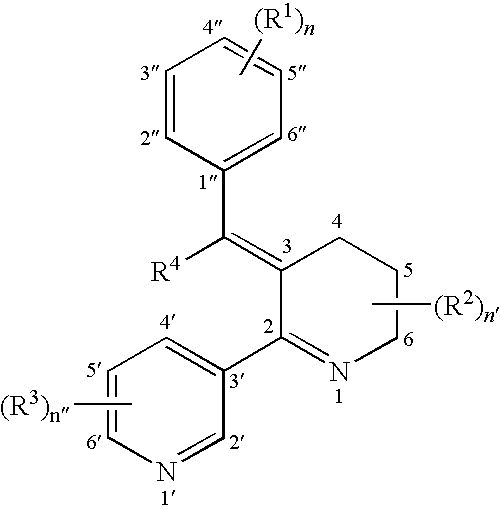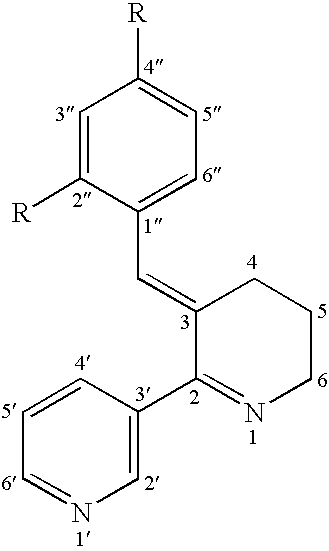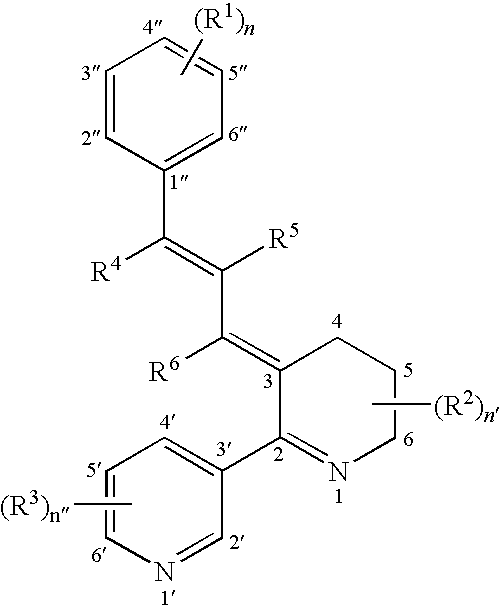Alpha 7 nicotinic receptor selective ligands
a nicotinic receptor and selective ligand technology, applied in the direction of biocide, cardiovascular disorder, drug composition, etc., can solve the problems of unsuitable treatment of certain peripheral diseases, misperception of sensory stimuli, etc., and achieve greater relative selectivity and greater relative selectivity
- Summary
- Abstract
- Description
- Claims
- Application Information
AI Technical Summary
Benefits of technology
Problems solved by technology
Method used
Image
Examples
example 1
Measurement of Alpha7 Receptor Binding Selectivities
[0329]After decapitation, washed whole rat brain membranes (200 μg of protein) were prepared according to the method used by Marks and Collins (1982). Displacement of 125I-labelled alpha-bungarotoxin (BTX) measured binding to alpha7 receptors; displacement of [3H]-labelled cytisine measured binding to alpha4beta2 receptors. Before use, the washed membranes were resuspended in 500 μl receptor binding assay saline (pH 7.4) consisting of 120 mM NaCl, 5 mM KCl, 2 mM CaCl2, 1 mM MgCl2 and 50 mM Tris-HCl. [3H]cytisine (35 Ci / mmole)-binding displacement experiments were performed essentially according to Flores et al. (1992), except that the incubation time was increased to 4 hr at 0 to 4° C. to ensure equilibrium during the competition binding assay. Binding of 1251-BIX (136 Ci / mmole) was performed at 37 C.° for 3 h; the saline solution mentioned above also contained 2 mg / ml bovine serum albumin. Nonspecific binding of each radioligand w...
example 2
Fused Ring Substituted Benzylidene-Anabaseines
[0331]Table 2 shows physical and binding properties of some 3-substituted benzylidene-anabaseines. Binding was determined using the procedure described in Example 1.
[0332]
TABLE 2RECEPTOR-BINDING AND PHYSICAL PROPERTIES OF SOME FUSEDRING 3-SUBSTITUTED ANABASEINESKiKiCompound(μM)Ki(μM)α4β2 / α7%NameStructureα7α4β2Ratio*PKaionizedLog P3-[3,4- (Ethylenedioxy) benzylidene]- anabaseine0.20 ± 0.01 n = 20.52 ± 0.01 n = 22.607.56 ± 0.0359.113.1033-[3,4- (Methylenedioxy) benzylidene]- anabaseine0.23 ± 0.002 n = 20.70 ± 0.07 n = 23.047.64 ± 0.0463.482.4283-[(6- Methoxynaphth-2- yl)methylene]- anabaseine0.37 ± 0.03 n = 20.60 ± 0.10 n = 21.627.29 ± 0.1243.672.6533- [(Benzofuran-2- yl)methylene]- anabaseine0.15 ± 0.003 n = 25.92 ± 1.06 n = 239.59 / 2 / 0433.903.86 ± 0.40*The alpha 7 receptor selectivities in this table are not normalized with the respect to DMXBA selectivity, as are the selectivities of the compounds in Table 1 (see footnote to Table 1 for ...
example 3
Synthesis of 3-(2,4-Diacetoxybenzylidene)-anabaseine
[0333]To a solution of sodium hydroxide (0.060 g, 1.50 mmole) in water (0.75 ml) at room temperature and strong stirring, isopropanol (4 ml) was added. When the mixture became clear, 2,4-dihydroxybenzylidene-anabaseine dihydrochloride (0.071 g, 0.20 mmole) was added and next acetic anhydride (0.104 ml, 0.112 g, 1.10 mmole) was added dropwise. After strong stirring at room temperature for 30 minutes the isopropanol was removed in a vacuum (at 45° C.), to the residue ethyl acetate (5 ml) was added and the mixture was washed with saturated sodium chloride solution (2×0.5 ml). The organic solution was dried over magnesium sulfate and evaporated in a vacuum (at 45° C.), giving the crude product (0.064 g, 88%). The product was purified by column chromatography on silica gel (7 g) with acetone-methanol (8-2) giving the pure product (0.043 g, 59%). 1H-NMR (CDCl3) delta 8.72 (dd, J=2.4, 0.9, 1H), 8.63 (dd, J=4.8, 1.8, 1H), 7.78 (dt, J=7.8, ...
PUM
| Property | Measurement | Unit |
|---|---|---|
| intracellular voltage | aaaaa | aaaaa |
| membrane potential | aaaaa | aaaaa |
| weight percent | aaaaa | aaaaa |
Abstract
Description
Claims
Application Information
 Login to View More
Login to View More - R&D
- Intellectual Property
- Life Sciences
- Materials
- Tech Scout
- Unparalleled Data Quality
- Higher Quality Content
- 60% Fewer Hallucinations
Browse by: Latest US Patents, China's latest patents, Technical Efficacy Thesaurus, Application Domain, Technology Topic, Popular Technical Reports.
© 2025 PatSnap. All rights reserved.Legal|Privacy policy|Modern Slavery Act Transparency Statement|Sitemap|About US| Contact US: help@patsnap.com



